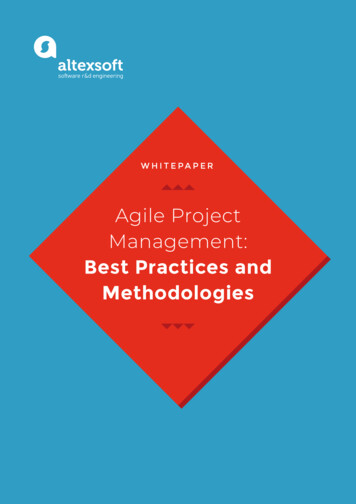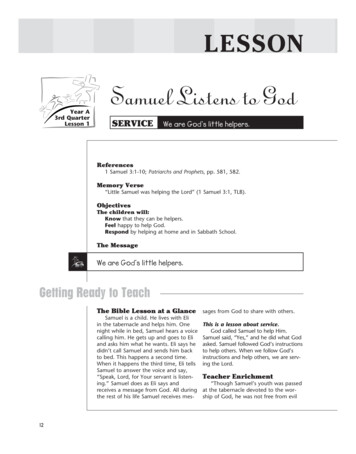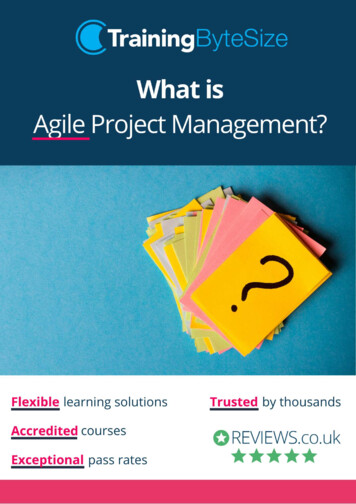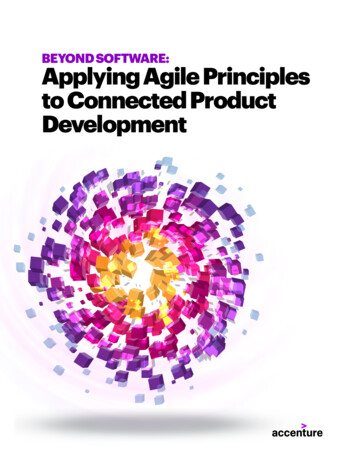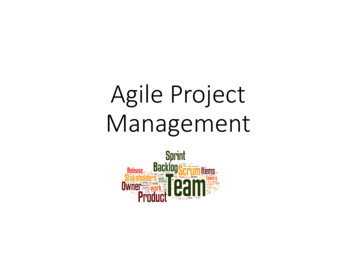
Transcription
Agile ProjectManagement
Why Agile?
What is Agile Project Management? Agile project management is an approach basedon: delivering requirements iteratively and incrementally throughout the project life cycle. At the core of agile is the requirement to exhibitcentral values and behaviours of trust Flexibility empowerment and collaboration.
Characteristics of Agile Agile project's defining characteristic is that itproduces and delivers work in short bursts (orsprints) of anything up to a few weeks. These are repeated to refine the workingdeliverable until it meets the client's requirements. Unlike the traditional waterfall projectmanagement Agile starts work with a rough idea ofwhat is required and by delivering something in ashort period of time, clarifies the requirements asthe project progresses. Collaborative relationships are establishedbetween stakeholders and the team membersdelivering the work
Agile projects need documentation, reviews andprocesses just as traditional projects do to meetrequirements, manage costs and schedules, deliverbenefits and avoid scope creep; Agile does not expect to fully understand therequirements before work can begin. Instead it emphasises the importance of deliveringa working product as something tangible for theclient that can then be refined until it fulfils theclient's needs. The key measure of project progress is this seriesof working deliverables.
Pareto Principle 20% of the User Stories(functional work)probably contain 80%of the customer value.So find them and dothose first Find the 20 percentthat delights customers,deliver them, andrepeat.
Prioritisation‐ MoSoCoW Must‐ Cannot deliver/golive without this. Should‐ Important butnot vital Could‐ Wanted ordesirable but lessimportant. ”nice tohaves” Won’t‐ team has agreedit will not deliver
Principles of Agile Customer collaboration over contract negotiation Individuals and interaction over process and tools Responding to change over following a structuredplan Prototyping/working solutions over comprehensivedocumentation
Benefits to Business/Clients Increased flexibility Increased transparency Speed up delivery Improve quality Satisfy stakeholders and realise efficiencies Decreased risk of missed objectives
Benefits to Project Management Reduced waste through minimization of resources Increased flexibility and adaptability to change Faster turnaround times Faster detection of issues and defects A Optimal project control Increased focus on specific customer needs Increased frequency of collaboration and feedback Builds accountability Encourages diversity of ideas
Agile Methodologies Scrum Lean Kanban DSDM
Agile Project Management withSCRUM Jeff Sutherland created the scrum process in 1993,he borrowed the term "scrum" from an analogy putforth in a 1986 study by Takeuchi and Nonaka,published in the Harvard Business Review. In that study, Takeuchi and Nonaka compare high‐performing, cross‐functional teams to the scrumformation used by Rugby teams. Scrum is the leading agile developmentmethodology, used by Fortune 500 companiesaround the world
SCRUM Values
SCRUM Framework
Detailed Framework
SCRUM Events Sprint Sprint Planning Daily Scrum Sprint Review Sprint Retrospective
SCRUM Roles SCRUM DevelopmentTeam‐ consists of sevenplus or minus two peoplewho are jointly responsiblefor the delivery of theproduct Product Owner‐ representsthe voice of the customerand has the authority tomake decisions about theproduct. SCRUM Master‐ is thekeeper of the process, theadvocate for the team, andthe protector of the team
SCRUM Development Team Cross‐functional (e.g., includes members with testing skills, and othersnot traditionally called developers: business analysts, designers, domainexperts, etc.) Self‐organizing / self‐managing, without externally assigned roles Plans one Sprint at a time with the Product Owner Has autonomy regarding how to develop the increment Intensely collaborative Most successful when located in one team room, particularly for thefirst few Sprints Most successful with long‐term, full‐time membership. Scrum moveswork to a flexible learning team and avoids moving people or splittingthem between teams. 6 3 members Has a leadership role
Product Owner Single person responsible for maximizing the return oninvestment (ROI) of the development effort Responsible for product vision Constantly re‐prioritizes the Product Backlog, adjustingany long term expectations such as release plans Final arbiter of requirements questions Decides whether to release Decides whether to continue development Considers stakeholder interests May contribute as a team member Has a leadership role
SCRUM Master Works with the organization to make Scrum possible Ensures Scrum is understood and enacted Creates an environment conducive to team self‐organization Shields the team from external interference anddistractions to keep it in group flow (a.k.a. the zone) Promotes improved engineering practices Has no management authority over the team Helps resolve impediments Has a leadership role
SCRUM Roles integrated with SCRUM Framework
SCRUM Roles integrated withSCRUM Framework
Tracking Progress‐ SCRUM Burndown Chart
Implication of Agile to ProjectManagementProject Management ImplicationFunctionPlanningLess formal, based on sprintsScopeCollaborative and interactive approach to requirementsas they are not fully known. Change is welcomed, scopecreep is expectedCostBased on number of sprints and effort, iterative, bottomupQualityEarly testing, continuous improvementProject TeamGreater communication and collaboration
Comparison of Agile and Waterfall
Waterfall Principles Sequential steps‐creating stage gates Strong projectdocumentation Low customerinvolvement
Waterfall challenges
Differences between Agile andWaterfall Traditional 'waterfall’approaches will tend totreat scope as thedriver and calculate theconsequential time andcost; Whereas ‘agile’commits set resourcesover limited periods todeliver products thatare developed oversuccessive cycles.
WATERFALLAGILE Detailed, long‐term project planswith single timeline Shorter planning based oniterations and multiple deliveries Definitive and rigid projectmanagement and team roles Flexible, cross‐functional teamcomposition Changes in deliverables arediscouraged and costly Changes in deliverables areexpected and less impactful Fully completed product deliveredat the end of the timeline Product delivered in functionalstages Contract‐based approach to scopeand requirements Collaborative and interactiveapproach to requirements Customer is involved only at thebeginning and end of a project Customer is involved throughoutthe sprint Linear‐phased approach createsdependencies Concurrent approach seeks toreduce dependencies
Similarities of Agile and Waterfall They both have the same goal i.e. deliver a qualityproduct in an effective and responsive manner Same Principles: plan the work out completely before beginninglock down requirements earlyinstitute multiple reviews24move forward in a step‐by‐step, sequential mannermove forward only when all parts of the previous stepswere complete capture all details with extensive documentation
They both work on the same Project Managementfunctions: CostScopeTime/ScheduleQuality They are both based on the same developmentstages: Analyze‐ the requirementDesign‐ a capability to satisfy the requirementBuild‐ the capabilityTest‐ the capability to ensure the requirement is metDeploy‐ the capability
WATERFALLAGILE
Hybrid Methodologies Opportunity exists to combine agile with othermethodologies such as waterfall to create a hybridsolution. Waterfall‐ waterfall can be used for Planning,where rapid or repetitive steps are not required Agile‐ Once a project enters the developmentphase, rapid and repetitive changes require adifferent approach and this is where Agile kicks into deliver the best results in the shortest amount oftime.
Using Waterfall and Agile
Benefits of Hybrid
References Sliger, M. (2011). Agile project management with Scrum. Paperpresented at PMI Global Congress 2011—North America, Dallas,TX. Newtown Square, PA: Project Management le‐project‐management‐scrum‐6269 APM (2018) Agile Project a‐resource/agile‐project‐management/ Rodov, A. & Teixidó, J. (2016). Blending agile and waterfall: thekeys to a successful implementation. Paper presented at PMI Global Congress 2016—EMEA, Barcelona, Spain. NewtownSquare, PA: Project Management on‐10213 Fair, J. (2012). Agile versus Waterfall: approach is right for my ERPproject? Paper presented at PMI Global Congress 2012—EMEA,Marsailles, France. Newtown Square, PA: Project ManagementInstitute. s‐waterfall‐approach‐erp‐project‐6300
What is Agile Project Management? Agile project management is an approach based on: delivering requirements iteratively and incrementally throughout the project life cycle. At the core of agile is the requirement to exh


